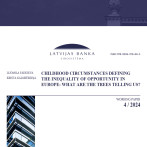Although manufacturing begins the year with a drop, future prospects have not deteriorated
According to the data of the Central Statistical Bureau, manufacturing volumes in January 2013 dropped 3.6% (month-on-month, seasonal factors excluded). The year-on-year growth rate, on the other hand, dropped substantially and the manufacturing volumes of January 2013 equalled those of a year ago. The year has begun with a minus, but it cannot be said to represent a significant trend or turning point: the status quo data and opinions expressed by manufacturers so far do not point to a substantial deterioration in the situation in this branch.
A substantial drop in production volumes was experienced by the pharmaceuticals sub-branch (minus 17.1% month-on-month, seasonally adjusted data) and equipment and appliances repairs sub-branch (minus 18.3%; includes ship and boat repairs). The big drops in both of these sub-branches are hardly surprising: we are used to the instability of their performance. In the output of the pharmaceuticals branch a drop at the beginning of the year was already predicted because the successful sales in the fourth quarter of 2012, according to enterprises, took place somewhat on account of future projections. Yet growth rates have been negative also in larger branches of manufacturing. The output volumes thus went down also in the production of construction materials, chemicals, wood and wood products as well as wearing apparel and textiles. Slight growth in January was observed only in the manufacturing of furniture, metals and fabricated metals as well as food products.
The confidence indicator compiled by the European Commission in February points to a further improvement in industry confidence determined primarily by a more positive than before outlook on the future amount of orders. The industry confidence indicator right now is the highest since January 2008 when it began to deteriorate substantially. This positive industry confidence, which has been quite long-lasting despite the problems in the euro zone may seem exaggerated, however, considering the operational profit indicators gradually being published by businesses for 2012, it becomes clear why there is so much optimism: the profits indicators are good. The positive piece of news is that industry confidence is improving not only in Latvia but in Europe at large, which can indicate a gradual improvement in the economic situation.
It is no secret that the successes and failures of Latvian manufacturing are related to the export markets. Thus in 2012, manufacturing sales in exports stabilized around 63.5% of the total. Viewed by sub-branch, it is obviously automobile production, production of computers, electronic and optical equipment as well as the production of wearing apparel that have been the most export-oriented; the sub-branches most oriented toward the domestic market have been the production of foodstuffs and construction materials. These facts should be kept in mind when analyzing the prospects of sub-branches in 2013. Given the crisis in the construction branch in Europe and thus a reduced demand for construction materials, it can be expected that growth will be weaker than in 2012 for wood and wood product producers (particularly those who produce the low end segment of value added), producers of metals and possibly also rubber and plastics products manufacturers. The recession in the auto industry will probably have a negative impact on those Latvian manufacturers who produce various components necessary for automobile production. Foodstuffs production is expected to continue stable development, albeit with relatively low rates of growth. The growth of the sub-branch is limited by the slow growth of private consumption. Pharmaceuticals branch, which demonstrated impressive growth already in late 2012, may again grow more rapidly. Continued growth is likewise expected in the production of electrical equipment, computers, electronic and optical equipment as well as transport vehicles.
A positive impetus for manufacturing could be the investment projects launched in 2012. A relatively large number of medium-sized (3-5 million lats worth) investment projects have been started. Moreover, these are not just investment projects in the wood industry or metal manufacturing. There are projects also regarding the so-called hi-tech branches. If these projects are successfully carried out, the Latvian manufacturing output could grow faster and become more diversified.
Textual error
«… …»






